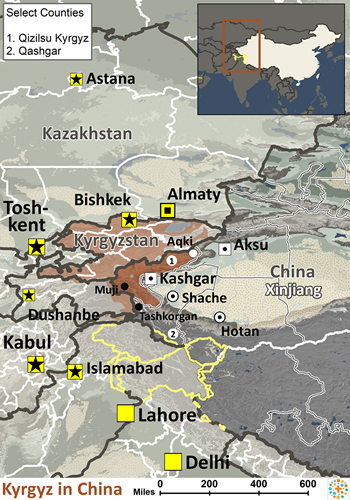In AD 751 the Chinese armies were defeated by the Arabs in a significant battle at Talas, in what is now Kyrgyzstan. One historian wrote, "This encounter was one of the most fateful battles in history. It marked the end of Chinese control over Central Asia. It also marked the beginning of Arab conquest of Central Asia. Soon the area was permanently converted to Islam." By the early 830s the Kyrgyz had clashed with the Uyghurs for control of Central Asia and defeated them. In 1944 the Chinese Nationalist government ordered the closure of many Kyrgyz pasture lands, under the pretext of "border security." The Kyrgyz, outraged at losing their livelihood, formed a government that gave birth to the Puli Revolution.
In the 1950s the Kyrgyz were granted status as one of China's official minority groups. The name Kyrgyz means "44 lasses." The Kyrgyz believe they are descended from 44 maidens. The Kyrgyz in China still retain their tribal identities.
Kyrgyz is a Turkic language. They used to have their own script, called the Yenisei script, until it was lost in the eighth century. No trace of it remains today. The Kyrgyz language in China contains two dialects: Northern and Southern Kyrgyz. Both dialects have the same vocabulary but employ different pronunciations.
The Kyrgyz have a famous epic, the Manas, that describes their past. The Manas is a virtual encyclopedia describing the customs, habits, and philosophies of the Kyrgyz, as well as recording their struggle for independence and freedom. Most Kyrgyz in China are involved with the production of carpets, horse gear, cloth, and wool.
Another ministry obstacle is their long-held allegiance to Islam and their belief in black magic.
In reality, although they are outwardly Muslims, most Kyrgyz follow a form of shamanism and black magic, where power through seductive signs and wonders is exerted. Demonstrations of this evil power are often aired on public television in Kyrgyzstan. The snake god, in particular, is held in great fear.
Swedish missionaries in Xinjiang listed 163 baptized believers by 1933, "mostly Uighurs and Kyrgyz, with some Chinese." In 1933 the missionaries were arrested and brought before Abdullah Khan, who "personally kicked and beat them. He threatened to kill them, claiming that their religious teaching was destroying the faith of many of his people." Most of the new Kyrgyz believers were murdered. Those whose lives were spared were imprisoned for many years. There are just a few known believers among the Kyrgyz in China today, although some ministries are focusing on them.
Without the guidance of Christ, these people are like sheep without a shepherd. They need the good shepherd in their families and communities.
Pray for the Lord to intervene in their families, calling people to his side.
Pray for "thrust out" workers.
Pray for their hearts to be drawn to the Lord of lords.
Pray for a church planting movement to thrive in their communities.
Scripture Prayers for the Kyrgyz in China.
Operation China, Asia Harvest Copyrighted © Used with permission
| Profile Source: Joshua Project |


























